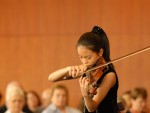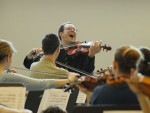Title
Dorothy DeLay helped so many violinists and teachers find their voices—but no one ever seems to have forgotten the sound of hers.
Body
Many of the late violin teacher’s former students—now professional violinists, writers, and violin teachers themselves—gathered at Juilliard this spring for the biennial celebration in her honor: the 2007 Starling-DeLay Symposium on Violin Studies, which took place from May 29 to June 2.
The symposium attracted not only Juilliard alumni, but also students, teachers, and performers from various backgrounds and locations around the world, including 37 states and 15 countries. In all, some 200 people came from around the world for this event, with its master classes, lectures, recitals, and general atmosphere of violin-love.
“I think it’s a tribute to Dorothy DeLay,” said New York violinist Nicholas DiEugenio, a participant at the symposium, “that so many people who are at the highest level of teaching and playing would come together to share their approach on the violin—and that each approach would be so very different. I think she spawned all that, by developing these people as individuals.”
 “She believed in involving the student in the decision-making about music,” Perlman said. “She would say, ‘Sugarplum, what are you missing here? Where are the sequences?’ or ‘Sugarplum, what’s your concept of G sharp?’”
“She believed in involving the student in the decision-making about music,” Perlman said. “She would say, ‘Sugarplum, what are you missing here? Where are the sequences?’ or ‘Sugarplum, what’s your concept of G sharp?’”
One of the most notable people DeLay helped to “develop” was Itzhak Perlman, a violinist of near-legendary stature and holder of the Dorothy Richard Starling Foundation Chair at Juilliard, whose appearance at the symposium was a big draw. Perlman brought 10 of his own students for a master class. As he talked with them and with the audience of teachers about musical expression, his remarks inevitably turned to DeLay.
“She believed in involving the student in the decision-making about music,” Perlman said. “She would say, ‘Sugarplum, what are you missing here? Where are the sequences?’ or ‘Sugarplum, what’s your concept of G sharp?’ ”
Though he studied with both DeLay and Ivan Galamian, “I worked harder for him than I did for her, because I knew she wouldn’t kill me,” Perlman joked. “Dorothy DeLay taught me how to think musically. The way I teach—a lot of it is inspired by her example.”
But did people come just to see Perlman? Or did they have other reasons?
“Number one, this symposium is at Juilliard; that’s cool in itself,” said Michael Godfrey, a violin teacher from Omaha, Neb.“There are kernels of truth, pearls of wisdom to help me. I’ve got the core of teaching pretty well, now I’m looking for the refinements, and little unanswered questions I can get an opinion on.”
“And it’s a wonderful way to get spoon-fed Simon Fischer’s book without having to read it!” Godfrey joked, as he waited for Fischer’s lecture on tone production to begin.
Godfrey was speaking of Fischer’s popular book, Basics, which actually begins with some words of gratitude for DeLay. Before he published one of his early articles, which described one of her tone-production exercises, Fischer called DeLay to ask permission, to make sure she would not feel he was “stealing” it from her. He writes: “She laughed and said: ‘Don’t worry. I learned it from Galamian, and he learned it from Capet, so feel free—what is important is that these exercises become known!’”
Fischer, who could be found autographing his books, Basics and Practice, and talking technique with individuals seeking an opinion on their set-up, had so much to say that he couldn’t get it done during his two morning lecture slots. So he called an extra evening class, where a sizeable crowd listened to his lecture on intonation late into the night.
“I love New York, and I love to come back,” said Juilliard alumnus Gloria Spurlock (B.M.’71, M.M. ’72, violin). Spurlock, who teaches 65 students in Lousiville, Ky., said that, though she did not bring any of her students this year, in the past she has brought a number of them: in 2005 she brought three students to observe, and in 2003 she brought 18 of them.
“I saw such a change in them,” Spurlock said of her students who attended in past years. “I saw a change in their attitude about music and about art. It was such an exhilarating experience for them.”
Exhilarating ... and even a little scary for those who actually participate.
Brandon Garbot, 13, of Portland, Ore., was one of 10 young artists chosen from around the world to play in the master classes and recitals at this year’s symposium. To get ready, he practiced performing as much as possible: he played two recitals at his teacher’s house, and he also played a few weeks before the symposium in the Oregon Music Teachers Association Competition, winning first place.
What was it like, playing in New York, at Juilliard, for hundreds of teachers with high expectations? “The first time I played, I was really tight and nervous,” Brandon said. But as the symposium went on and he played more, “I learned to relax myself before going out on stage.”
His teacher, Clarisse Atcherson of Portland, who was attending the symposium for the third time, was pleased at the opportunity for her student. “He got to play for some big-name, wonderful teachers; he got to play in recital; he got to see New York and to see Juilliard,” Atcherson said. “It enabled him to connect with some of these teachers who could be a future teacher. Just to get to play for someone like [Cleveland Institute of Music violin professor] Paul Kantor (B.M.’77, M.M.’78, violin), or watch Itzhak Perlman teach, is a wonderful opportunity.”
In addition to Perlman and Kantor, master class teachers included Juilliard’s former dean, Stephen Clapp (M.S.’65, violin), and New England Conservatory professor and Juilliard faculty member, Donald Weilerstein (B.M.’63, M.S.’66, violin). Cincinnati College-Conservatory string chairman Kurt Sassmannshaus (M.M.’79, violin), the creator of Violinmasterclass.com, was there for the entire week before giving the last master class. Lecturers included Fischer, Indiana University violin professor, Mimi Zweig; the symposium’s artistic director, Brian Lewis (B.M.’91, MM ’93, violin); and University of Texas at Austin professor, Robert Duke.
Duke, one of the few faculty members who was not a violinist, lent the event his wonderful perspective about the nature of teaching and learning: “Young people who are just starting to teach often can imitate all the things that wonderful teachers can do,” Duke said. They can imitate voices, they can tell pithy stories. “But the magic runs deeper than that.”
Indeed. How did the same teacher inspire one person to become a world-class artist, another to write 195 articles and three books, another to take all he knew about the violin and put 175 master class videos on the Internet—and yet others to continue this symposium, to play in orchestras, to teach?
As Lewis said, “Anything that is unique in the student—we want to leave that there. That is something Dorothy DeLay did beautifully.”






